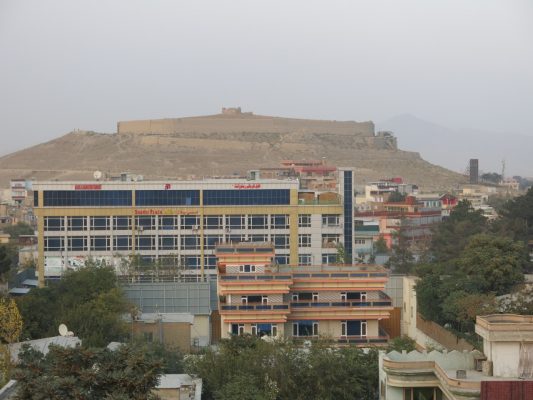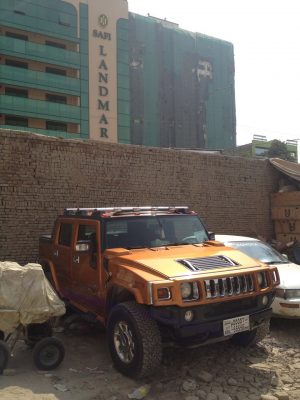On the Unheralded Transformation of Kabul
“Everybody knows the war is over./ Everybody knows the good guys lost.”
-Leonard Cohen
Everyone knows that there has been no progress and no development in Afghanistan, that the West’s efforts there since the overthrow of the Taliban have been a gigantic waste of blood and treasure. Everyone knows that the Afghans are corrupt, vicious, and ungrateful, and want us to leave immediately. Everyone knows that U.S. air strikes invariably kill vast numbers of civilians and therefore recruit ever more people to the insurgency. Everybody knows that all the aid money has been squandered, or stolen and taken to Dubai for laundering. Everybody knows that our clueless troops spend their days and nights offending local sensitivities by burning Korans and outraging the sanctity of the women’s quarters—that is, when they are not desecrating enemy corpses. Finally, everyone knows that the Taliban has won the war and is waiting to retake Kabul as soon as the last foreign troops are no longer in the fight—which, President Obama has now informed us, will be the case at the end of 2015.
There have been few times in the modern era when “everybody” has been quite so misinformed or so willing to see catastrophe when none has taken place.
To acknowledge this does not require an optimistic take on Afghanistan’s future or even a belief in the original rightness of the Afghan “nation-building” mission. It is merely a matter of looking past the overall impression fostered by a mainstream media that long ago grew bored of both the war and the complexity of the actual country known as Afghanistan.
I went back to Afghanistan this past winter after an absence of seven years. Flying this time on a commercial airline—one of several that serves the country—I encountered a Kabul transformed, and almost entirely for the better. This came as something of shock. I follow news and events Afghanistan quite closely, and this abundantly obvious, indeed unmissable, transformation generally has gone unnoticed or unmentioned by those whose very job it is to report and comment on the country.
The new international terminal isn’t ritzy, but it is partly solar-powered and has free Wi-Fi. You don’t feel like you’re flying into a war zone or a city traumatized by terrorism until you exit the terminal and walk several hundred yards, in sight of watchful Afghan army soldiers and Humvee gunners, to get to a parking lot that is too far away for even the largest vehicle bomb to do much damage. Then you get onto a highway that, like all the main roads in central Kabul, is of astonishingly good quality for this part of the world, and it’s packed with traffic. Seven years ago, when I traveled with International Security Assistance Force foot patrols through town—inconceivable now that all security in the city is run by Afghans—most of those roads were quiet, full of potholes, and largely free of civilian vehicles.
The physical and economic growth of the city was immediately apparent. From the middle of town to the suburbs, Kabul has been astonishingly altered by the arrival of shiny shopping malls, vast wedding halls, and restaurants. There are huge new suburbs spreading out across what was recently farmland or desert. Some are planned and boast rows of 20-story apartment blocks. Others, illegal and slum-like, spread up the slopes of the city’s surrounding dun-coloured hills and, lacking running water, look and smell like Brazilian favelas.
On the outskirts of the city are busy concrete factories and huge lots filled with Caterpillar and Komatsu diggers. Everywhere you look, there is frenzied economic activity. The center of town is protected by the “ring of steel”—a series of checkpoints. The paramilitary police who guard them are nothing like the ones I remembered from 2006 and 2007. They don’t look like sloppy, sleepy Third World cops. They are alert, equally suspicious of white, brown, and yellow, and carry their weapons like people who know how to keep them clean. They ape the look of American and allied Special Forces to an almost absurd degree, with goggles on their helmets, combat knives strapped to their body armor, and flashlights attached to their rifles.
Inside the ring of steel is a street where every other store sells the latest in computers and electronic goods. (You can choose between genuine, name-brand SD cards and USB sticks or decent fakes from China.) There is another street with several huge sporting-goods shops. Presumably they were set up to cater to the military contractor market, but they have found a domestic market and have stock superior to anything in either India or Pakistan. Everywhere there are small, lively workshops. Seven years ago, I remember, there were already two surprisingly good cellular telephone networks. Today there are more, and there are mobile phone shops and billboards for 4G cellular services all over town. Coverage was at least as good as New York City’s. At least two-thirds of the population have cellphones.
In the center of town, about a third of the men are wearing jeans instead of salwar kameez (the long shirt and pajamas worn by both men and women in Afghanistan and Pakistan). About half the women are not in the light blue burqas that are ubiquitous in much of the countryside, and I saw some in tight jeans and the flimsiest of head scarves.
The traffic in Kabul, once as sparse as you would expect in a devastated, civil war–torn city, is now comically terrible. There are rush hours at least twice a day during which vehicles barely move. These would seemingly provide amazing opportunities for terrorists who are not themselves stuck in traffic. As in other parts of the Third World, most cars and trucks are Toyotas, though in one small parking lot in the center of town I was surprised to come upon a gold Hummer, two Mercedes, a BMW, and a Ferrari.
Over the three weeks I spent in the Afghan capital, I was struck by the lack of a visible foreign military presence in the streets. There is a huge base at the airport, and the ISAF headquarters and the ultra-secure embassy complexes are very visible. An hour out of town are the military academies sponsored by the British and Americans. But Kabul does not look or feel like a city under foreign military occupation. You do see from time to time convoys of huge mine-protected armored trucks heading to and from the U.S. base at the airport. You are more likely to encounter mini-convoys of three or four bullet-proofed Toyota SUVs filled with people wearing helmets and body armor as per embassy or ISAF regulation. They maneuver together and are a constant irritation to Afghan drivers.
Most of the city center is astonishingly clean. I was startled to see groups of men in uniform overalls picking up trash, something almost unimaginable in this part of the world. In India or Pakistan or Nepal, when trash is picked up, it is by rag pickers, the poorest of the poor, or consumed by the cows, pigs, and dogs that cohabit the streets of subcontinental cities with the homeless.
Most remarkable of all is the number and size of the so-called poppy palaces—the gaudy, high-walled mansions of Kabul’s rich. Despite the nickname, they are as likely to have been built by men who have made fortunes from construction and security contracts as from drugs. They are protected by the latest in cameras and security systems. Some were built by speculators aware of the extortionate rents that foreigners were willing to pay for villa accommodation within the ring of steel.
That was when the city was heaving with aid workers, foreign-security contractors (mostly expelled by President Hamid Karzai after his reelection in 2009 and replaced by Afghan security guards), consultants, and entrepreneurs. Rents have all but collapsed with the shrinking of the international presence that has been underway since Barack Obama’s December 2010 announcement of a 2014 departure date for most U.S. forces. When the “internationals” presence was at its height in the mid- to late-2000s, a lot of money was spent and thousands of foreigners enjoyed a spectacular social life that people deployed to Baghdad at the same time could only dream of. The Thursday-night poolside parties at L’Atmosphere bar-bistro and other places were wild, with that febrile carpe-diem spirit often found in war zones and which owes as much to boredom as fear.
Today the brothels (loosely disguised as Chinese restaurants) have closed, and it is the Afghans themselves, not the aid workers and embassy officials, who are buying khaki cargo pants and stolen PX products at the huge Bush Market. There are still a half dozen or so restaurants patronized by foreigners, however, and all are delightful places with lanterned gardens, nominally illegal booze, excellent food, and, for the most part, serious security. Much to the shock of the international community, one of these restaurants, Taverna du Liban, was recently attacked by the Taliban, who murdered 21 of its guests and staff. Despite that horror, the city generally has been safer for expats than outsiders might imagine, and security has improved in the last year and a half. There are even tourist groups to be seen visiting the spectacular Babur Gardens and the ruins of the Darul Aman palace. According to longtime foreign residents, ordinary crime is a bigger threat than terrorist outrages, especially in certain parts of the city where muggings are rife.
There have been a handful of kidnappings of expats during the past five years, but these have mostly been opportunistic crimes by local criminal gangs or the results of nefarious dealings by those expats; it is well known that some of the foreigners who work in Kabul are really there because hashish and heroin are readily available. Most kidnappings are of locals and by locals and connected to business disputes. The level of violence in general is lower than in murder capitals such as Caracas, Tegucigalpa, Kingston (in Jamaica), or Juárez, let alone Baghdad. Most of the time the city is quiet and does not feel like a capital at war. When things do go wrong, however, they do so dramatically and bloodily.
The Taliban are masters of the “spectacular.” Although fewer and fewer of their attacks come to fruition and although the effectiveness of Afghan security forces has radically increased, any attack on a foreign target is, inevitably, a strategic triumph in the information battle space. Such attacks foster the impression of chaos and insecurity and imply the possibility of a Taliban victory to media consumers at home. The Taliban’s leaders have long understood that the really important battle for hearts and minds isn’t taking place in Afghan villages but in the newsrooms and cities of the West. One of the worst errors made by the Coalition and foreign observers has been mistaking the Taliban for mere rural primitives. Indeed, they understand the imperatives of information warfare against democratic countries at least as well as Western militaries, perhaps better.
Over a $10 beer at the famous Gandamack Lodge, the preferred drinking hole of the press corps and much of the international community, I asked Jeremy Kelly, the longtime Kabul correspondent for The Times (London) and other papers, why I had never seen any articles about the transformation of the city and its economic vivacity. Kelly, a tough thirtysomething Australian who has traveled through much of Afghanistan by motorbike, sighed and said that editors just aren’t interested in hearing that kind of news from Afghanistan. It does seem to be the case that mainstream newspaper and TV editors got bored with the Afghan war years ago. And therefore the only Afghan news that interests them now are “green on blue” attacks by Afghan troops against international forces, alleged allied atrocities, and successful terrorist attacks: all stories that seem to confirm the wisdom of getting out as soon as possible.
Of course, Kabul is not Afghanistan—although at least an eighth of the population lives in the capital. But then neither does Helmand or Kandahar City or Khost, where the war with the Taliban is most evident, represent Afghanistan. The Northern city of Mazar-i-Sharif is even more orderly and peaceful than Kabul. And Kandahar, in the Pashtun heartland, seems to be quiet and firmly in government control. While Kabul has grown to be a city of at least 5 million people, the tripling of the populations in cities such as Heart and Kandahar reflects a deeper transformation of the country, one that continues behind the storyline of a lost war and wasted, failed international assistance.
The country is now much more urban than it was a decade ago, with almost half the population living in cities. And in terms of development, no country in the world has made so much progress so quickly. Life expectancy has risen from 37 in 2000 to around 60 today. Maternal mortality, the highest in the world, has dropped from 1,600 per 100,000 births to 367 per 100,000, and the infant mortality rate is half what it was. Even more significant, per capita GDP increased fivefold and the country has enjoyed 9 to 10 percent growth annually since 2000—admittedly from a very low base.
Vast amounts of aid have, of course, been stolen, misused, or wasted. But you only have to spend a few days in Afghanistan to see that it did not all end up in bank accounts in Dubai. It’s also worth remembering that few heavily aided countries are subject to the same scrutiny as Afghanistan. Having seen a lot of aid in a lot of countries,1 I’m not convinced that Afghans are more likely to steal or misuse aid dollars than citizens of any other brutalized, impoverished, and politically dysfunctional country.
Foreign analysts tend to focus on the role of aid in Afghanistan’s development, but they should pay more attention to what is arguably a greater engine of change. The country’s economic, cultural, and political life have all been reshaped by the return of more than 5 million Afghans from foreign exile. Whether they were in Iran or Pakistan (which each had about 2 million Afghans) or in America and Europe, the returnees have brought with them skills, knowledge, expectations, and entrepreneurial drive that were previously lacking. It is because of the exiles in Pakistan that cricket is now a national Afghan sport, and it is because of the exiles in Iran that Afghanistan won a bronze medal for Taekwondo in the 2012 Olympics. Aid was not responsible for setting up the first television channel or mobile network; an Afghan-Australian businessman was.
A fifth of the population, as opposed to 6 percent in 2001, has access to reliable electricity. Sixty percent of the population, including 48 percent of women, own cellular phones. More than 65 percent of the population has access to the Internet. Primary-school enrollment has risen from less than a million in 2001 (only 5,000 were girls) to more than 8 million (more than 3 million are girls). University enrollment has gone from less than 8,000 in 2001 to more than 77,000, with many Afghan students studying abroad. There are 84 television channels and 50 independent radio stations.
Thanks to these changes and vastly better highways between cities, Afghans are much less isolated from each other and the world than they once were. They are also becoming much better educated and therefore less vulnerable to, or interested in, the Taliban’s appeal. Polls indicate that the great majority of Afghans do not want the Taliban to return to power and have a negative view of the insurgency. Almost 50 percent of the population are younger than 15 years old. They have no memory of life under the Taliban and have opportunities for literacy and education that much of the adult population were once denied.
Are we defeated?
It is difficult to get a wholly convincing, comprehensive impression of the military situation in Afghanistan. But you don’t have to be an optimist about the future or unduly credulous of ISAF pronouncements to see that government forces are not (yet) on the defensive and that the Taliban have little chance of taking over any province or any city in the near future. This is despite spectacular official corruption, nepotism, and ministerial incompetence; despite the pathological obstructiveness of Karzai; despite the inconsistency and inconstancy in allied strategy; despite dreadful mistakes by Coalition forces; despite the cash flowing to the insurgents from the Gulf states; despite the tremendous skill and determination of the Taliban’s sponsors in Islamabad; and finally, despite the hugely demoralizing effect of President Obama’s announcement of a U.S. pullout in 2014 regardless of the facts on the ground.
There is no question that Obama’s announcement had a catastrophic effect on morale, pushed Afghan fence-sitters onto the Taliban side, made intelligence-gathering harder, and weakened American leverage over the Afghan government. And it is still hard to believe that an American president could so foolishly or carelessly undermine the efforts of his own troops. On Obama’s recent Memorial Day visit to Afghanistan, he seemed to have a new awareness of “the sacrifices we have made…the gains you have helped to win.” But five years of the Obama presidency have taught observers to take such rhetorical allusions very lightly.
Afghanistan’s 350,000-strong National Security Forces have nearly doubled in size since 2009 and now conduct 95 percent of operations against the Taliban. During the 2012 and 2013 fighting seasons, they led the charge against the insurgents and consolidated control of all 34 provincial capitals. Coalition trainers are often impressed by the skill of Afghan bomb-disposal teams and the physical courage of Afghan National Army soldiers, especially when well led, and when corruption and incompetence in the officer corps have not undermined the supply of food and ammunition to the troops. Afghanistan’s special forces in particular are able to operate effectively on their own. These include specialized police units and the paramilitary forces of the powerful intelligence service known as the National Directorate of Security.
On the other hand, local police in Afghanistan have earned a justified reputation among frontline Coalition troops as unreliable, underpaid, corrupt, incompetent, lazy, sometimes treacherous, sometimes brave, dope-smoking pederasts. Given that policemen everywhere in South Asia tend to be little more than uniformed, licensed bandits, this should not have come as such a surprise to Western trainers and planners. They also have an unenviably high death rate, as they are considered soft targets by insurgents.
At least the Afghan National Army is now decently salaried with an increasing number of soldiers, paid via mobile-phone accounts rather than in cash. Despite having to recruit from a relatively illiterate population, it has become a much more professional and tactically proficient fighting force than it was only a few years ago.
Unfortunately, the Coalition’s focus on getting trained infantrymen into the field as soon as possible—which was perhaps understandable when the Coalition thought it had years to set up a modern army—meant that relatively little attention was paid to teaching Afghan leaders and ministries about planning, logistics, and budgeting, or to equipping Afghan forces with fire support in the form of aircraft and artillery, or to giving them an ability to transport their own forces across the country. Unlike Coalition forces, the Afghans have little ability to evacuate their casualties by air, and given their high-casualty rates, this has a bad effect on morale, retention, and recruiting.
When it was announced that the United States and its Coalition allies would be all but abandoning the mission at the end of 2014, to the shock and dismay of Afghans and Coalition forces alike, ISAF started scrambling to fill some of these gaps. There have been some successes: For a long time it was feared that the Afghans would not be able to maintain the Humvees or Ford trucks supplied to the army and police once the U.S. contractors had home, but mechanics have now been trained to do so.
On the other hand, the Coalition was remarkably sleepy about the need to develop indigenous air capacity. Only in the last year or so has it begun in earnest to train and equip2 Afghan pilots, and in any case the Afghan air force has yet to find a way to keep expensively trained, English-speaking pilots and maintenance crews from leaving to work for the country’s new commercial airlines.
Fortunately, even if today’s Afghan military does not have all the capacities or capabilities of the Soviet-trained Afghan armed forces, it does not have to face an insurgency as large or as well funded and well equipped as the Mujahadeen were in the 1970s and ’80s. That is why almost everyone agrees that there is very little chance of the Taliban’s capturing any Afghan city, let alone Kabul, after the departure of ISAF forces later this year. They do control large areas of certain provinces, but they lack the capacity and perhaps even the desire to take any of the country’s cities.
This assumes that the international community will not breach its commitment to fund the Afghan National Security Forces through 2017. It also assumes that the Bilateral Security Agreement between Afghanistan and the United States will be signed before the U.S. administration loses patience and pulls out all its troops. The BSA, as it is known, sets out the conditions for a continued American military presence in Afghanistan until the end of 2014. Without such an agreement, there will also be no long-term U.S. civilian presence in the country and no U.S. ally would consider keeping forces in Afghanistan. It was supposed to have been signed by the end of 2013, and the Obama administration threatened a “zero option”—pulling every soldier and adviser out of the country by the end of 2014—if it wasn’t signed by the end of January 2014. After all, the two governments had been negotiating the deal under which U.S. troops would stay after 2014 to “train, advise, and assist” Afghan forces for more than a year.
Sticking points included an unsuccessful Afghan demand that America guarantee Afghanistan’s security against foreign incursions, i.e., against Pakistan, and give an “apology” for past mistakes, as well as America’s insistence on total immunity against prosecution for its troops. The BSA was endorsed by the Afghan Parliament and then by a Loya Jirga assembly of tribal elders, but Karzai refused to put his signature to it.
Luckily, both of the leading presidential candidates in the running to succeed Karzai and most of the political class are very keen to see the agreement signed. That means that the big danger is not so much the Taliban’s returning in triumph to destroy what they see as the fleshpots of Kabul, but a return to the warlordism and civil war that devastated the country after the Soviet departure.
At the time of writing, the Afghan presidential election is entering its second phase, since no candidate won the first round. It is significant that the election was held at all. It is no secret that Karzai did not want to give up power. As late as November, there was much talk in Kabul of the president’s postponing the elections for “security reasons” or declaring a state of emergency, perhaps after ensuring a certain amount of chaos in key districts. He is also rumored to have been building a residence on the presidential estate so he can be a permanent “adviser” to his successor. Perhaps because his refusal to sign the BSA with the U.S. does not have the agreement of tribal leaders (as evidenced by a recent Loya Jirga) or because he knew that postponing the election might push even the Obama administration too far, Karzai seems to have accepted that he will indeed be leaving office.
This is just as well. Karzai’s behavior over the past four years, especially toward the allies whose financial and military support ensure his government’s survival, begs for psychiatric explanation. Among other things, he has accused NATO of secretly arming the Taliban. Notoriously, and perhaps in an attempt to win over Taliban sympathizers or Pakistan’s hawks, he has repeatedly berated ISAF for achieving nothing in Afghanistan3 and inflicting civilian casualties. At the same time, he has not expressed any sympathy for victims, Afghan and other, of the Taliban, let alone the 3,400 NATO troops killed there since 2001.
Some of this hostility may reflect an eccentric jealousy of the popularity of Coalition provincial reconstruction teams, whose effectiveness and concern for the welfare of the population contrasted so starkly with those of central-government officials. But Karzai seems to have little sense of the extent to which his anti-Western rhetoric alienated the countries that bankroll his regime, and also to have entertained the delusion that he could replace America and the West with regional supporters such as Turkey, Iran, and India, perhaps boosted by China or Russia.
His profound paranoia became apparent before the 2009 elections—elections that he shamelessly fixed—when he was convinced that the United States and its allies were determined to find a candidate to replace him. The irony was that America was, if anything, too easy on Karzai. Our toleration of depredations by his family and friends deeply alienated ordinary Afghans who assumed that America knew and approved of that corruption. Had Washington been more ruthless while it still had abundant leverage, that might not have been the case.
Another explanation for his irrational behavior puts blame on the Coalition and is more plausible. Throughout the mid-2000s, the United States and ISAF forced Karzai and his government to go along with the pretense that Pakistan was not hosting and sponsoring, and in some cases arming and advising, some of the worst Taliban groups. Afghan representatives were made to attend “tripartite” meetings on Afghanistan’s security with the Coalition and Pakistani officials. Those officials must have been laughing into their teacups as straight-faced American diplomats talked about the “contribution” of their Pakistani “partners.” If our troops who faced Pakistani-sponsored Talibs and occasionally Pakistani special forces were disgusted by this, it was perhaps unfair to expect Karzai to take part in such a grotesque charade and stay sane.
A smooth transition of power to either Abdullah Abdullah or Ashraf Ghani will represent a triumph for both the Coalition and Afghanistan. Ghani is unique in Afghan politics. A Pashtun intellectual with a Ph.D. from Columbia University who honed his expertise in development while working for the World Bank, he was finance minister from 2002 to 2004. He co-wrote a book, Fixing Failed States, that is required reading for anyone interested in aid and development. Dismayingly, this technocrat chose as his running mate the Uzbek warlord General Abul Rashid Dostum, who was a key ally of the United States in 2001 and of the USSR during the 1980s, and who has never given up his private army.
His rival for the presidency, Dr. Abdullah Abdullah, is a former foreign minister and trained ophthalmologist. He is half Tajik and half Pashtun and fought alongside the Northern Alliance leader Ahmed Shah Massoud, who was murdered by al-Qaeda just before 9/11. Abdullah won the most votes in the first round of the election. A strong critic of Karzai’s anti-Western rhetoric, he has said he would sign the BSA within a month of being elected. But one of his two running mates is “Engineer” Mohammed Khan, a former deputy head of the Hezbi I Islamist party, whose military wing is the second largest insurgent group after
the Taliban.
Neither is entirely attractive. But both leaders are apparently sane and promise to be more pragmatic and less obstructionist than Karzai. There is a chance they will not be quite so intent on a centralized form of government that is fundamentally unsuited to Afghan society and prone to corruption and bad governance. Both leaders clearly understand that Afghanistan desperately needs U.S. forces to stay after 2014 in sufficient numbers to lead, guide, train, and support the Afghan military if the developmental gains of the last decade are not to be lost.
At the end of May, President Obama announced that America will keep 9,800 troops in Afghanistan after the end of 2014, assuming that the next Afghan president signs the BSA. That is an improvement on the 5,000 troops the White House had originally been considering, a number so inadequate to the task that it would almost have been better to have none at all. U.S. commanders generally believe they would need a minimum of 14,000 troops on the ground until 2017 to carry out the mission effectively and safely, and perhaps considerably more, depending on what happens in the next fighting season. Still, it’s possible that 9,800 could be sufficient to back up and train Afghan forces, especially if the U.S. keeps enough air power in the region.
Unfortunately, the president also has declared that, irrespective of the facts on the ground, the deployment will be cut in half by the end of 2015. All but 1,000 of those remaining forces will be gone by the end of 2016. It is hard to exaggerate just how foolish and irresponsible it is of Obama to put a fixed date on the deployment, thereby telling the insurgents that no matter how exhausted they may be, all they have to do is hold on for two years.
But the truly awful aspect of this retreat is that America may be about to abandon Afghanistan just when it seems to have turned a corner—when a new leader is about to take power after a peaceful democratic process, when economic growth is transforming life for millions, and when the security forces are beginning to become genuinely effective in a limited but promising way.
It wouldn’t be the first time that the United States has chosen to lose a war without being defeated in the field, or risked rendering meaningless a huge expenditure of blood and treasure, or let down a beleaguered ally. But it would likely rank high in any list of the nation’s strategic blunders and shabby betrayals, and its fallout might be felt for many years to come in the region and beyond.
Afghanistan is not the only country that has changed dramatically since late 2001.
Footnotes
1 See my book Aiding and Abetting (Civitas, 2013).
2 The Afghan air force was due to be given 20 inexpensive, easy-to-maintain but highly effective COIN aircraft Brazilian-American A-29 Super-Tucano propeller attack planes. However, thanks to the Senate Appropriations Subcommittee on Defense, it will now get only a handful. This is a decision that could have far-reaching effects, given that Afghan forces are used to working with U.S. forces that rely on consistent and effective close air support. Afghan forces are also used to relying on Coalition air transport to move them around the country, and most of that will not be available after this year. The November 2013 U.S. cancellation of a contract to buy Russian MI-17 transport helicopters—familiar, powerful, and simple to operate—supposedly because the exporter has ties to the Syrian regime—will also adversely affect Afghan military capacities after we go.
Sixteen second-hand Italian Air Force Alenia G-222 transport aircraft bought for the Afghan air force have been mysteriously retired. It’s not clear if they became unflyable because of corruption-related Afghan failures to maintain them properly or if, as seems likely, the Italian suppliers failed to supply promised maintenance support as per their contract.
3 Karzai told the BBC in October 2013: “The entire NATO exercise was one that caused Afghanistan a lot of suffering, a lot of loss of life, and no gains because the country is not secure.”







